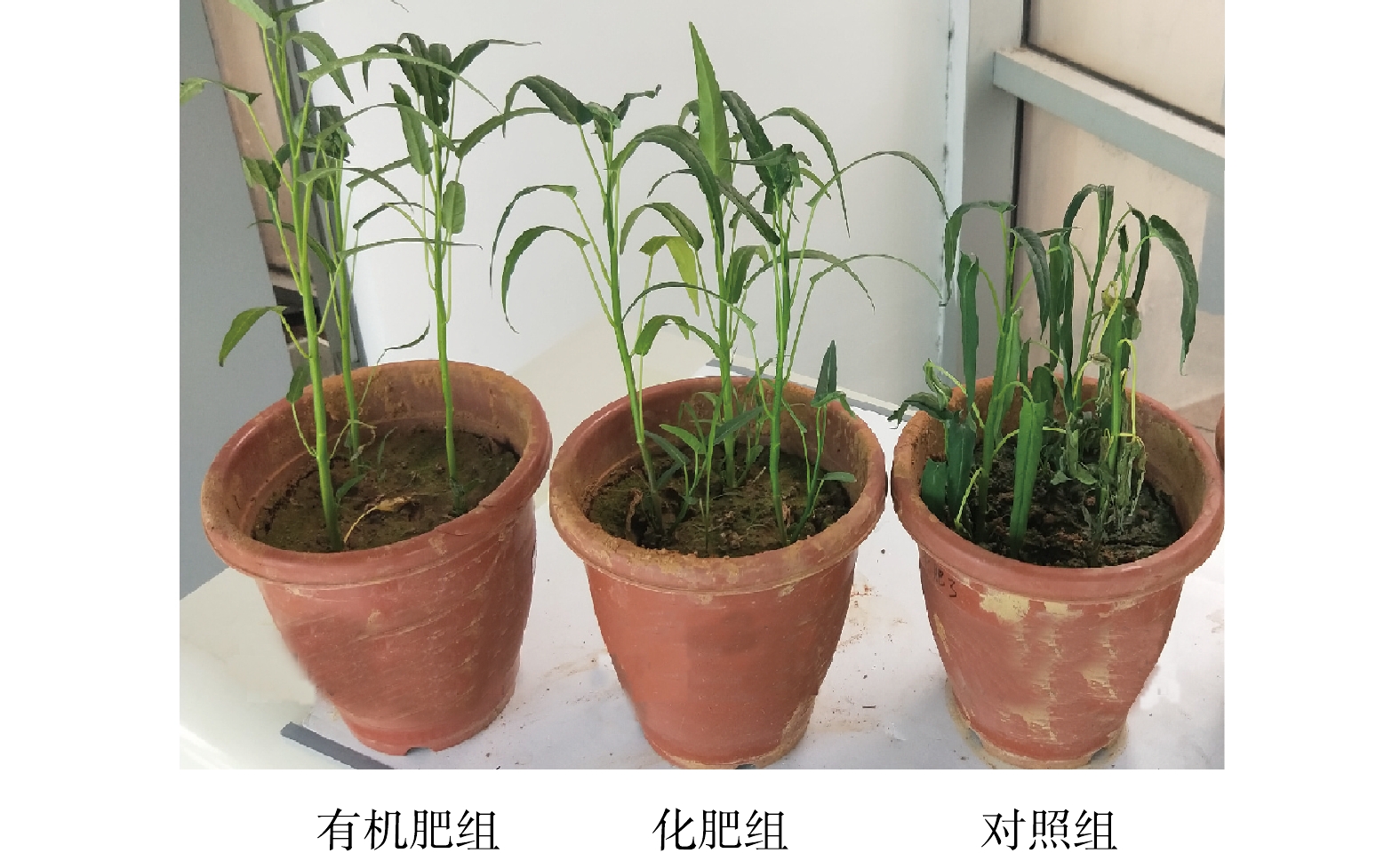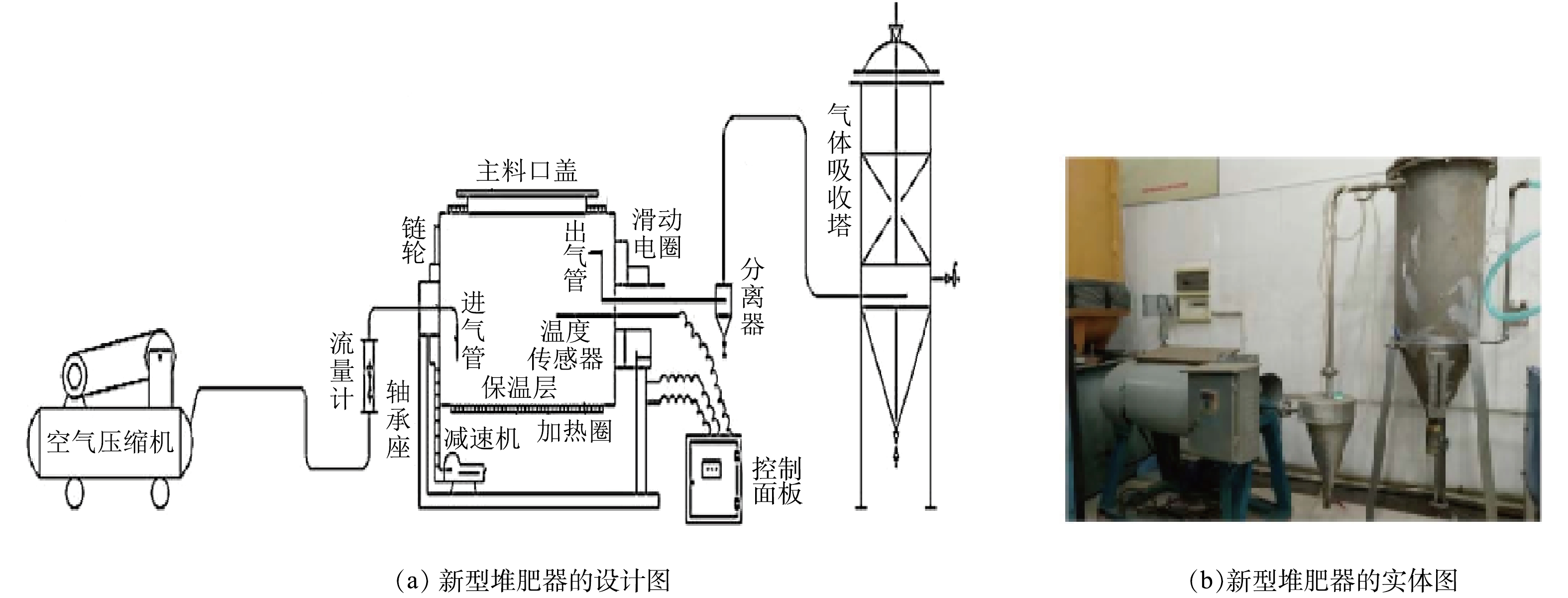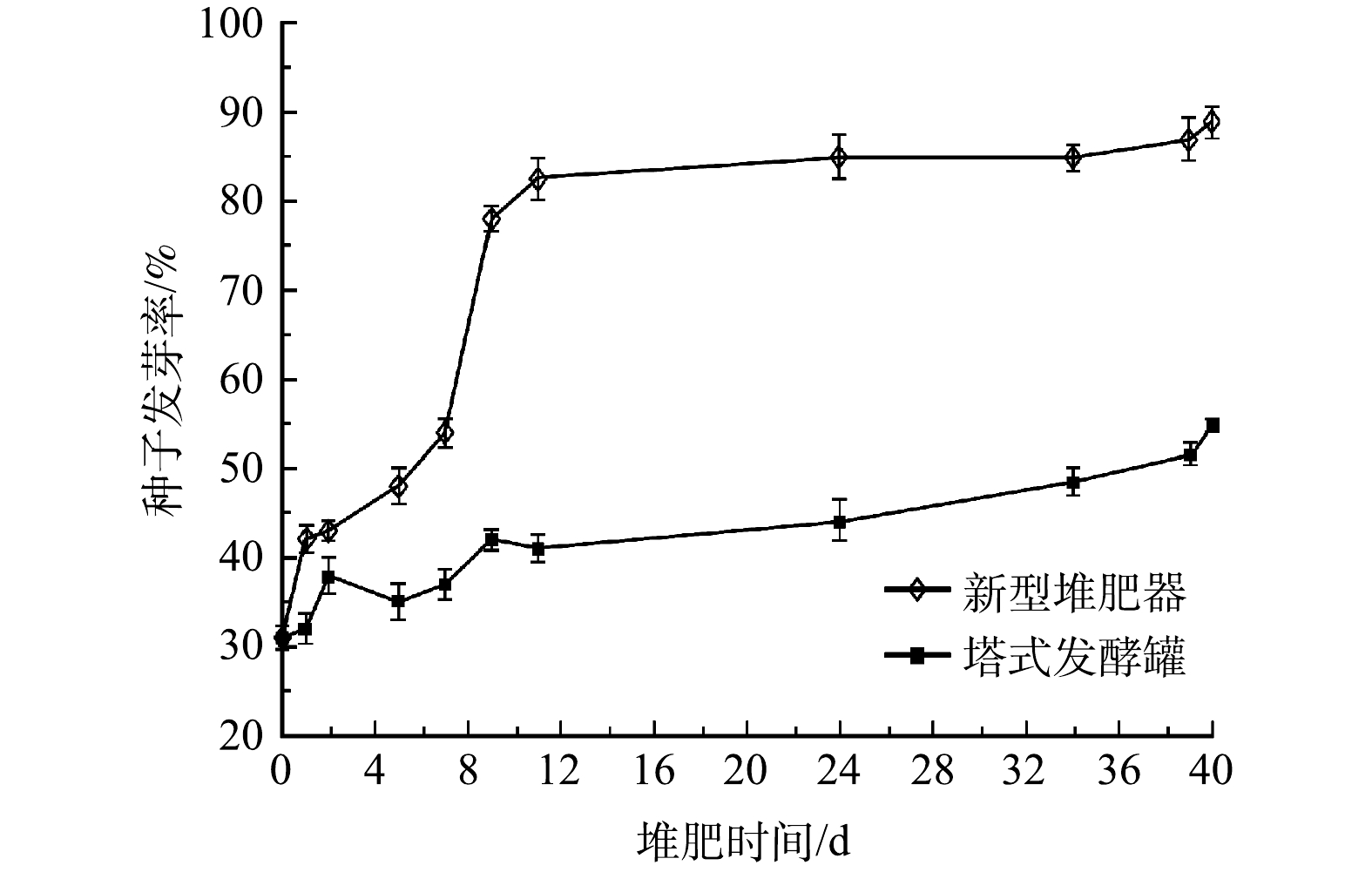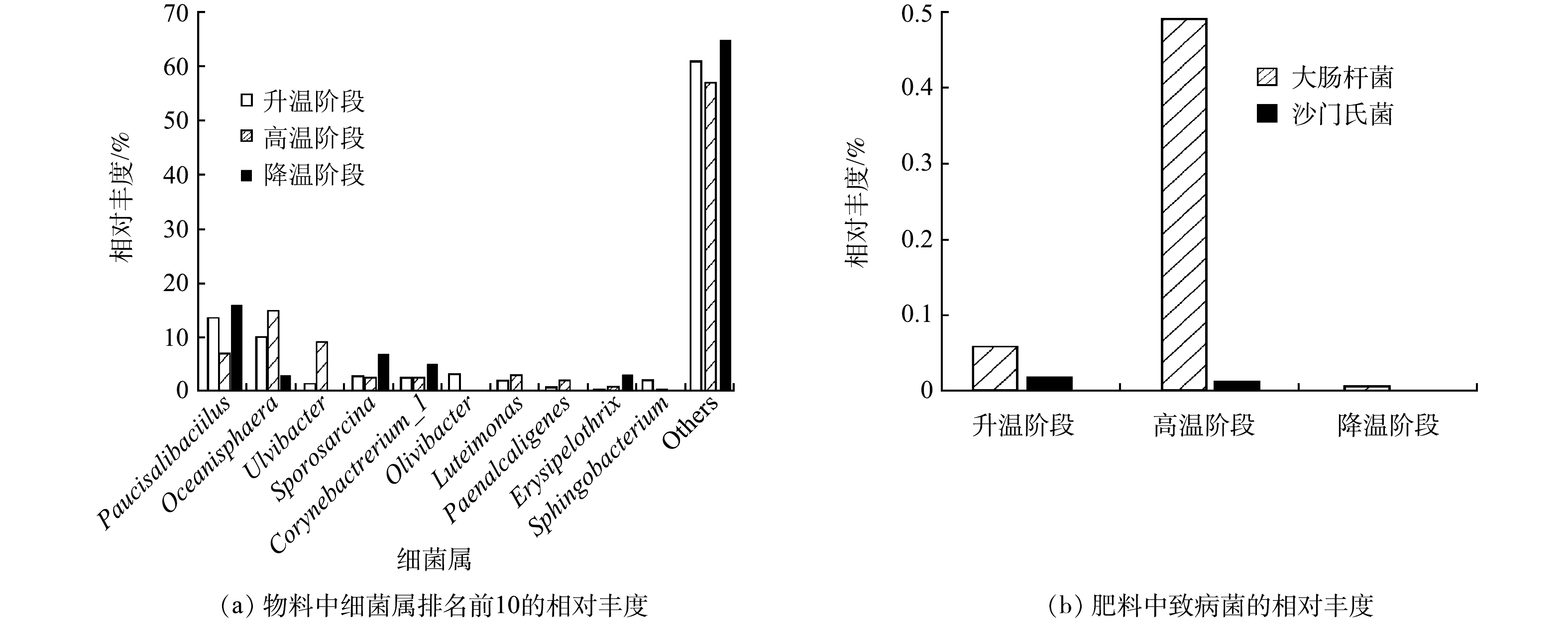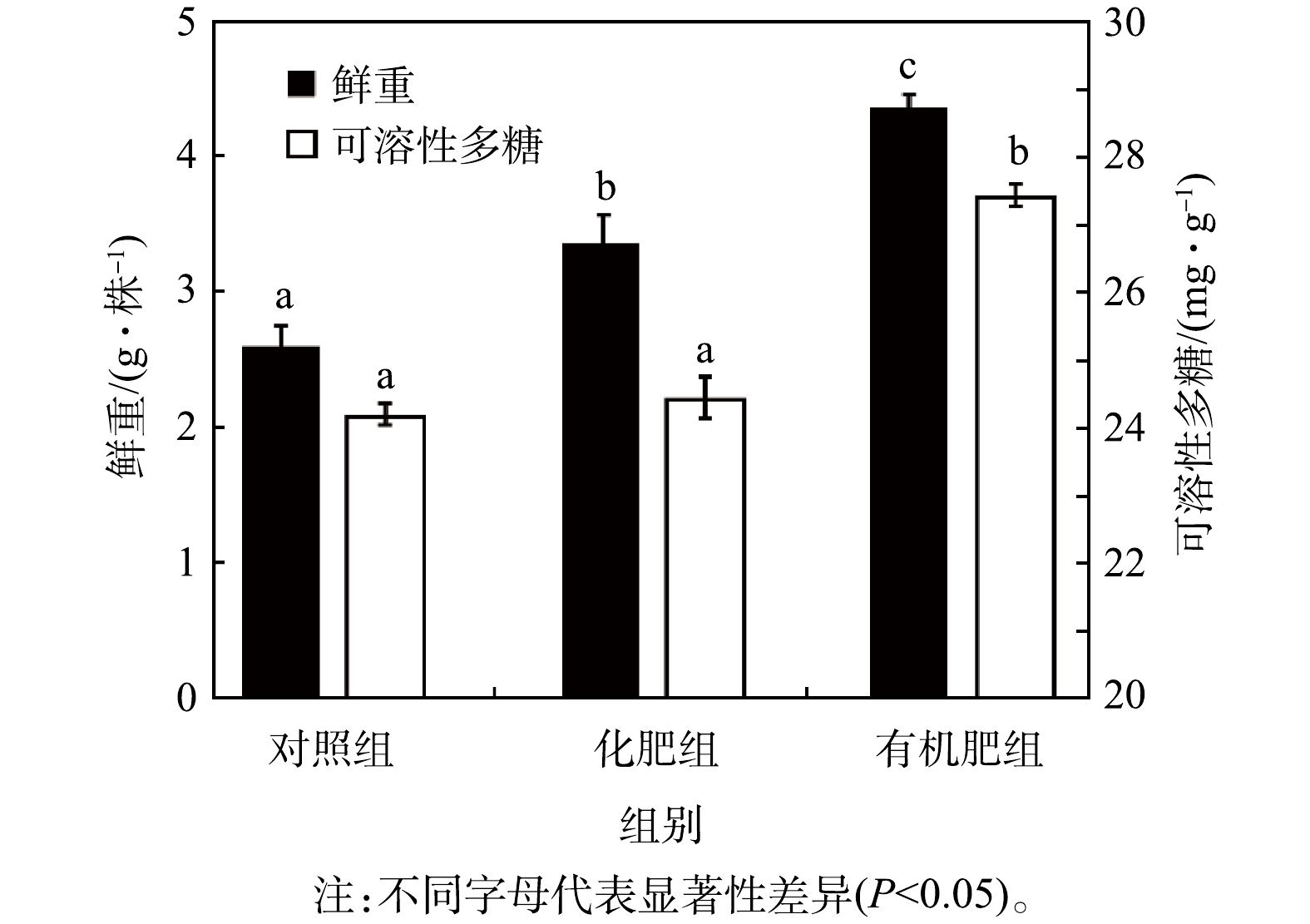-
近年来,畜禽养殖过程中产生的大量粪污引起了严重的环境污染,已严重阻碍了畜禽养殖业的可持续发展[1-2]。未经处理的畜禽粪污富含致病菌且成分不稳定,在储存过程中会释放大量甲硫醇、氨气、硫化氢和丙烯醛等10多种恶臭有毒还原性气体,严重危及人畜健康[3-4]。然而,畜禽粪污作为一种富含氮、磷、钾等营养物质的有机固体废物,又是可用于促进农作物生长的重要肥料资源[5-6]。堆肥技术主要是通过微生物对畜禽粪污中不稳定的有机物质进行降解,生成稳定的腐殖质类物质,从而将其转化为高价值有机肥料,实现畜禽粪污的资源化利用[7-8]。畜禽粪污堆肥处理不仅可以解决环境污染问题,而且所得的肥料有助于改善土壤环境、提高土壤肥力,对实现畜禽业及农业可持续发展具有重要意义[9]。
好氧堆肥法可有效地脱臭及灭菌,有利于肥料的养分保持,是我国畜禽粪便处理的主要方式。然而,现有的好氧堆肥反应器在堆肥过程中存在非自动化、物料腐熟度差异大、控温困难、氮损失严重等缺陷,限制了好氧堆肥反应器的广泛应用[10-11]。因此,加快低成本、环保型、高效自动化堆肥反应器的开发,对促进畜禽粪污肥料化应用尤为重要。
本研究采用可调控式新型高温好氧堆肥器,以谷壳(粉)作为堆肥辅料,分析鸡粪谷壳在堆肥过程中的理化性质,并利用吸收塔将堆肥过程中释放的氨气转化为磷酸铵镁(MAP),再添加至鸡粪谷壳有机肥料中,从而生产出优质商品有机缓释肥料。
全文HTML
-
鸡粪和谷壳原料化学特性见表1。堆肥菌种为自筛选获得的以嗜热好氧纤维素分解菌为主体的堆肥混合菌群,主要包括真菌、放线菌、耐热芽孢杆菌等菌种,活菌总数大于20×108个·g−1。
-
新型高温好氧堆肥器主要由控制面板、发酵罐、空压机通风系统、气体吸收塔等4个部分组成(图1)。其中,控制面板用于控制堆肥器内物料的温度及发酵罐的搅拌频率,同时显示堆肥器湿度。发酵罐总容积设计为75 L,根据《搅拌与混合设备设计选用手册》[12]中反应罐有效容积计算,有效容积为50 L。发酵桶为圆柱体桶装结构(Ф60 cm×40 cm),采用旋转式搅拌。空压机通风系统采用入功率0.37 W、输出转速5~25 r·min−1。气体吸收塔的容积为188 L,塔内装有Ф25 mm的塑料阶梯环填料,用于吸收堆肥发酵过程逸出的氨气,以镁盐沉淀剂转化为磷酸铵镁(MAP)。塔式发酵罐的容量为30 L,运行物料容量为20 L,罐体内部用聚氨酯作保温层,罐体采用全封闭式,发酵产生的废气经处理系统处理后,直接排出罐外。采用涡轮上翻搅拌及液压驱动,以保证罐体内腐熟物满载荷运行。
-
本实验采用鸡粪和谷壳粉按C/N=25混合,再用去离子水调节混合物料水分含量至60%,并搅拌混匀得堆肥物料,最后添加菌剂于堆肥反应器中进行发酵反应。塔式发酵罐进行的实验堆料高度为50 cm、物料重20 kg、堆肥时间40 d。新型堆肥器处理物料50 kg,每48 h自动搅拌1次,每次5 min,总堆肥时间为40 d。采用五点取样法采集堆肥样品,分别采集了第0、1、2、5、7、9、11、34、39、40 d的样品,每份取样50 g装于自封袋中密封,并于4 ℃条件下保存。
-
1)鸡粪谷壳有机肥料有效性评估。取12个花盆(25 cm×20 cm),分为空白组、化肥组(尿素46% TN)和鸡粪谷壳有机肥(以下简称“有机肥”)组,每组4盆,每盆约3 kg土壤,种植15粒空心菜种子。空白组不添加肥料;化肥组在土壤中添加3.88 g尿素(与有机肥组等量的含氮量计算得出);有机肥组在土壤中添加鸡粪谷壳经新型堆肥器堆肥40 d后产生的100 g肥料(1.86 g TN、3.27 g TP、1.57 g TK)。花盆置于户外种植,每日浇水1次,每7 d进行1次大水量灌溉,发芽后栽培30 d采收。
2)MAP肥料有效性评估。采用盆栽实验评估新型堆肥系统回收氨气产生MAP的肥效性。盆栽实验设4个处理组:T1为对照组(不施肥)、T2为有机肥组、T3为有机肥+MAP组(有机肥和MAP各占50%)、T4为MAP组。各处理组的TN含量相同,每组3盆,每盆约3 kg土壤,种植10粒小白菜种子。空白组不添加肥料;其他组每盆按1 kg土壤添加0.5 gTN计算添加肥料的量。待种子发芽后,每盆保留6~8株生长相近的幼苗进行后期分析。
-
1)气味、色泽及形状评估。采用感官评估法,每次5人对样品进行样品气味、色泽及形状进行评估。其中,气味评估主要包含粪尿味、臭味较淡、臭味较浓、臭味强烈、无臭5个等级;色泽主要包含灰褐色、褐色、黑色3个等级;样品形状主要有块状、粒状及球状3个等级。
2)温度及pH测定。每天测定肥堆上、中、下3个层次的温度,计算平均值并记录室温;将新鲜堆肥样品与水按1∶10(质量体积比)比例混合振荡2 h,上清液测定pH。
3)化学成分测定、种子发芽率测定和16S rRNA序列分析。总碳、总氮、水分含量、钾含量测定方法参考文献[13];可溶性糖测定参考文献[14];种子发芽率(GI)的测定参考文献[15];16S rRNA序列分析参考文献[16]。
1.1. 供试原料
1.2. 实验装置
1.3. 堆肥和取样
1.4. 肥料有效性的盆栽实验
1.5. 分析方法
-
根据图2和表2可知,随着堆肥化的进程,堆体表观发生了显著的变化。堆体颜色由最初的灰褐色逐渐转变成黑褐色,由局部的黏稠状逐渐转变为疏松且具有一定结构的状态。此外,随着堆肥时间的延长,鸡粪有机肥料的臭气味逐渐消失,最后无臭味(表2)。该现象产生的主要原因可能是,微生物降解有机物产生的硫化物及叠氮化物等引起的,之后随着微生物逐渐死亡,使得臭气味消失。物料在反应器中连续发酵40 d后,堆体由灰褐色的块状逐渐变成黑色的圆球状(图2)。在堆肥过程中,堆体表观状态的变化,符合典型腐熟堆肥的情况。
-
温度是监测堆肥过程性能的主要参数之一。堆肥的热量是微生物通过降解有机物质,在促进自身生长的同时产生的。由图3(a)可知,新型堆肥器和塔式发酵罐中堆体的温度变化趋势主要分为3个阶段。第1阶段为快速升温期,由起始温度升至峰值温度。新型堆肥器和塔式发酵罐中堆体温度均从第5天开始快速升温,分别在第9、11天达到峰值温度,其峰值温度分别为63.2 ℃、52.8 ℃。在堆肥前期,好氧微生物可快速分解物料中的可降解有机物并释放能量,使得堆肥温度急剧升高[16-17]。新型堆肥器在堆肥过程中对物料进行了适当的滚筒式翻动,这有利于微生物的扩繁增殖和氧气的传输,从而提高好氧微生物的活性、物料中有机物的降解速率及能量的释放,因此,新型堆肥器中的堆体升温速率高于塔式发酵罐。第2阶段为缓慢降温期,即堆体中峰值温度缓慢下降至略高于室温的时期。新型堆肥器中堆体温度下降速度低于塔式发酵罐中的堆体。新型堆肥器和塔式发酵罐中堆体的降温期分别需要30及25 d左右。堆体中有机物含量不足,微生物活性及释放热量的下降,导致温度逐渐降低。此外,由于新型堆肥器具有较好的保温效果,因此,堆体温度下降速度较慢。新型堆肥器中堆体温度在第7~30天保持在50 ℃以上,共23 d,符合高温堆肥的要求(GB 7959-1987)。第3阶段为腐熟期,堆肥40 d后,新型堆肥器和塔式发酵罐中的堆体温度几乎与室温保持一致,无法继续往下降,因此,可以认定堆肥反应基本结束。
由于水分含量的高低与微生物活性和温度密切相关,鸡粪谷壳粉堆肥过程保持在适当的水分含量,可有效提高堆肥的效果。堆肥的最佳初始含水量一般在55%~65%,此含水量能够为微生物提供合适的湿度环境[18-19]。因此,在本实验中,鸡粪谷壳的水分含量控制在60%左右。在鸡粪谷壳粉堆肥过程中,水分含量呈现逐渐下降的趋势。由图3(b)可知,堆肥11 d后,新型堆肥器中的物料水分含量由60%逐渐下降到50%,而塔式发酵罐中物料水分由60%下降到40%,经40 d堆肥之后分别降低至29.24%和26%。堆肥过程中物料水分下降的主要原因是,在微生物分解有机质、消耗水分及堆肥过程中,不间断的通气搅拌导致了水分的损失[20-21]。新型堆肥器中,物料中水分损失速率低于塔式发酵罐。这主要是由于:1)在新型堆肥器中散状的物料经过不间断的通气和搅拌结成圆球状阻碍了水分蒸发,而塔式发酵罐中的原料在堆肥过程中是处于散状的;2)在新型堆肥器是一个相对密闭的装置可有效防止水分蒸发,而塔式发酵罐是自然通风且比表面积较大,因而加速了水分的挥发。
由图3(c)可知,新型堆肥器中物料的pH由8.02逐渐增加至8.65,之后下降至8.51,呈现先上升后下降的趋势;而塔式发酵罐中的物料pH也呈现类似的变化,但变化幅度低于新型堆肥器。在新型堆肥器中,堆体温度较高,嗜热微生物代谢蛋白质,导致氨氮的不断产生,最终使得pH持续升高,并且高于塔式发酵罐中的物料pH[22]。而在后期,因物料结构过于致密导致孔隙度过小,不能为微生物提供足够的含氮有机物和O2,造成局部厌氧而导致有机酸积累,最终导致pH降低。
-
种子发芽率是评价堆肥腐熟度和植物毒性的重要生物学指标。一般认为,当种子发芽率(GI)达到50%时,病原菌基本被消灭,肥料对植物无毒害影响;如果GI值超过80%则认为堆肥完全腐熟,对植物没有毒性[16]。据图4显示,随着堆肥化的进行,新型堆肥器和塔式发酵罐所得的肥料GI值呈现先增加后保持稳定的趋势。鸡粪谷壳在新型堆肥器处理11 d后,其GI值达到80%左右,可以认为堆肥完全腐熟,之后保持稳定。采用塔式发酵罐堆肥处理24 d后,GI值仅为60%左右,之后保持稳定。表3显示了鸡粪谷壳在新型堆肥器中处理40 d后所得有机肥的主要理化特性。结果显示,鸡粪谷壳有机肥中含有50.53%有机质、1.86%总氮(TN)、3.27%总磷(TP)及1.57%总钾(TK),且无有害菌群,基本达到中华人民共和国农业行业有机肥料标准(NY 525-2012)[13]。
-
通过高通量测序技术所扩增的16S rDNA V4区域特点,分析了鸡粪谷壳在新型堆肥器中高温好氧发酵过程中3个关键性温度阶段细菌群落多样性变化。图5(a)显示了样品升温期、高温期、降温期在属分类水平上最大丰度排名前10的菌种。在升温期,Olivibacter属、Sphingobacterium属的相对丰富度高于高温期和降温期,这2个菌属均具有降解芳香族化合物功能,可有效降解物料中的纤维素及半纤维素;在进入高温期,随着温度的升高和营养物质的消耗,大量嗜温细菌进入休眠或死亡状态,Oceanisphaera属、Ulvibacter属、Luteimonas属、Paenalcaligenes属等嗜热微生物的相对丰富值逐渐提高,有利于纤维素及木质素等有机物的进一步降解。放线菌的丰度增加为堆肥腐熟度的一个标志[23],在降温期,Paucisalibacillus属、Sporosarcina属、Corynebacterium属于放线菌门的系列,其相对丰度值逐渐升高,这表明堆肥物料基本上已经腐熟。
在粪污有机肥发酵中,由于大肠杆菌及沙门氏菌易随流水污染水源,从而间接危害人群和畜禽的健康,因此被作为肥料的安全检测指标。由图5(b)可知,在高温阶段,大肠杆菌和沙门沙门氏菌数量最多;随着堆肥的进行,2种菌的数量快速下降。可见,在高温堆肥过程中,大肠杆菌和沙门氏菌逐渐被消灭。随着堆肥的进行,部分不适宜在堆肥中生存的菌群逐渐优胜劣汰;新型堆肥器在堆肥过程中可以杀灭有害微生物,达到畜禽粪污无害化处理,以保证有机肥料的安全性。
-
图6显示了空心菜经过鸡粪谷壳有机肥、化肥和对照盆栽实验30 d后的生长情况。可以看出,盆栽30 d后,有机肥组的株高明显高于化肥组和对照组。通过对空心菜地上可食部分鲜重的分析发现,对照组及化肥组的平均鲜重分别为2.52和3.26 g,而有机肥组空心菜的平均鲜重为4.36 g,分别比对照组和化肥组增加了42.20%和25.22%。通过图7可知,施加有机肥栽培的空心菜其鲜重和可溶性糖含量均明显高于空白对照组与化肥组,这表明有机肥的施加对空心菜的生长与养分积累起到了促进作用。
-
图8显示了不同施肥条件下小白菜的生长情况,可见,新型高温好氧堆肥器回收氨气产生的MAP对盆栽小白菜株高和湿重的提高均有促进作用。结果显示,经过30 d的生长,小白菜的株高在T3组比T2组提高了120%;T4组的也比T2组的提高了40%左右。经过30 d的生长,T3组小白菜地上部分平均湿重为6.02 g,比T2组(4.18 g)和T4组(5.24 g)分别提高了44.02%和14.89%。MAP具有较好的缓释性,若用MAP代替部分氮肥,能有效减少土壤氮素淋洗的损失,从而减少温室气体(NH3)排放,并能起到有缓解土壤酸化等作用。有报道指出,MAP的氮素淋洗损失显著低于尿素,而且其N2O的释放量能够减少75%以上,可为植株的生长提供更为持久的有效养分[24-26]。
2.1. 堆肥过程物料表观变化
2.2. 堆肥过程中物料温度、水分及pH的变化
2.3. 堆肥时间对种子发芽率(GI)的影响
2.4. 堆肥过程中微生物多样性分析
2.5. 鸡粪谷壳有机肥的肥效
2.6. 新型高温好氧堆肥器回收氨气产生MAP的肥效
-
1)新型高温好氧堆肥装置可以回收堆肥过程中释放的氨气,形成的MAP可作为肥料。
2)鸡粪谷壳混合物(C/N=25)在新型堆肥器堆肥处理40 d后,可形成黑色无臭味、无有害菌群、圆球状的有机肥,其养分基本达到我国有机肥料标准(NY 525-2012)。
3)鸡粪谷壳有机肥能够缓慢并稳定地释放氮磷钾等植物生长所需的营养元素,有利于空心菜对营养物的吸收;新型堆肥器回收氨气产生的MPA添加至鸡粪谷壳有机肥中,可进一步提高有机肥的整体肥效。





 DownLoad:
DownLoad:





